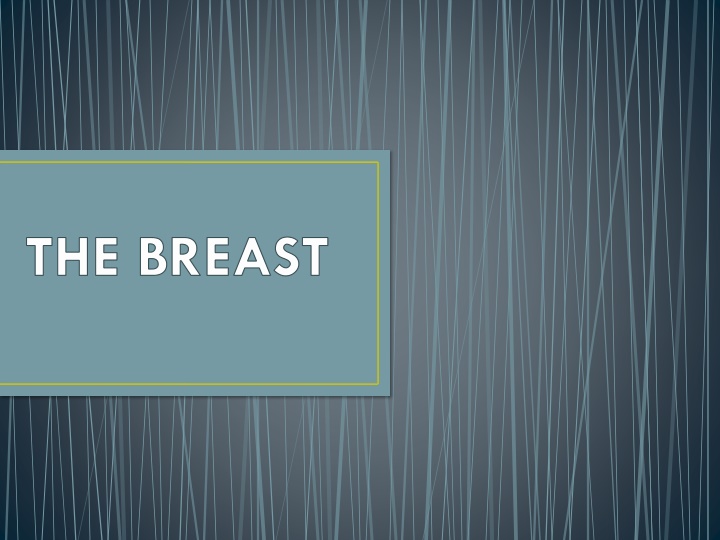
Surgical Anatomy and Investigation of the Human Breast
Explore the surgical anatomy of the human breast, including details on lobules, Cooper's ligaments, nipple structure, and lymphatics. Learn about investigative methods such as mammography, ultrasound, MRI, and needle biopsy for assessing breast health. Delve into the complexity of the mammary gland in a comprehensive guide.
Download Presentation

Please find below an Image/Link to download the presentation.
The content on the website is provided AS IS for your information and personal use only. It may not be sold, licensed, or shared on other websites without obtaining consent from the author. If you encounter any issues during the download, it is possible that the publisher has removed the file from their server.
You are allowed to download the files provided on this website for personal or commercial use, subject to the condition that they are used lawfully. All files are the property of their respective owners.
The content on the website is provided AS IS for your information and personal use only. It may not be sold, licensed, or shared on other websites without obtaining consent from the author.
E N D
Presentation Transcript
SURGICAL ANATOMY The human breast is generally described as overlying the second to the sixth ribs and extending from the lateral border of the sternum to the anterior axillary line. Actually, a thin layer of mammary tissue extends from the clavicle above to the seventh or eighth ribs below, and from the midline to the edge of the latissimus dorsi posteriorly. This fact is important when performing a mastectomy, the aim is to remove the whole breast.
The lobule is the basic structural unit of the mammary gland. The number and size of the lobules vary: most numerous in young women. From 10 to over 100 lobules empty via ductules into a lactiferous duct, of which there are 15 20. Each lactiferous duct is lined with a spiral arrangement of contractile myoepithelial cells and is provided with a terminal ampulla, a reservoir for milk or abnormal discharges.
The ligaments of Cooper are hollow conical projections of fibrous tissue filled with breast tissue; the apices of the cones are attached firmly to the superficial fascia and thereby to the skin overlying the breast. The areola Contains involuntary muscle arranged in rings as well as radially in the subcutaneous tissue. The areolar epithelium contains numerous sweat glands and sebaceous glands. The nipple is covered by thick skin with corrugations. Near its apex lie the orifices of the lactiferous ducts. The nipple contains smooth muscle fibers arranged longitudinally; thus, it is an erectile structure, which points outwards.
The lymphatics of the breast drain predominantly into the axillary and internal mammary lymph nodes. The axillary nodes receive approximately 85% of the drainage and are arranged in the six groups. The internal mammary nodes are fewer in number. They lie along the internal mammary vessels deep to the plane of the costal cartilages, drain the posterior third of the breast and are not routinely dissected, although they were at one time biopsied for staging.
INVESTIGATION OF BREAST SYMPTOMS 1. Mammography. 2. Ultrasound: useful in young women with dense breasts in whom mammograms are difficult to interpret, and in distinguishing cysts from solid lesions. 3. Magnetic resonance imaging: is useful in: 1. to distinguish scar from recurrence in women who have had previous breast conservation therapy for cancer. 2. to assess if the tumor was multifocal and multicentric in lobular cancer. 3. to assess the extent of high-grade ductal carcinoma in situ (DCIS). 4. it is the best imaging modality for the breasts of women with implants. 5. a screening tool in high-risk women (because of family history). 4. Needle biopsy/cytology
Discharges from the nipple Discharge from the surface Paget s disease Skin diseases (eczema, psoriasis) Rare causes (e.g. chancre) Discharge from a single duct Blood-stained: Intraduct papilloma Intraduct carcinoma Duct ectasia Serous (any colour): Fibrocystic disease Duct ectasia Carcinoma
Discharge from more than one duct Blood-stained: Carcinoma Ectasia Fibrocystic disease Black or green: Duct ectasia Purulent: Infection Serous: Fibrocystic disease Duct ectasia Carcinoma Milk: Lactation Rare causes (hypothyroidism, pituitary tumor)
Acute and subacute inflammations of the breast Bacterial mastitis: Lactational mastitis is seen far less frequently than in former years. Most are caused by S. aureus and, if hospital acquired, are likely to be penicillin resistant. The intermediary is usually the infant; after the second day of life, 50% of infants harbor staphylococci in the nasopharynx. Although ascending infection from a sore and cracked nipple may initiate the mastitis, in many cases the lactiferous ducts will first become blocked by epithelial debris leading to stasis. Once within the ampulla of the duct, staphylococci cause clotting of milk and, within this clot, organisms multiply.
Acute and subacute inflammations of the breast Bacterial mastitis: CLINICAL FEATURES The affected breast, or more usually a segment of it, presents the classical signs of acute inflammation. Early on this is a generalised cellulitis but later an abscess will form. TREATMENT During the cellulitic stage >>> an appropriate antibiotic, such as flucloxacillin or coamoxiclav. Feeding from the affected side may continue if the patient can manage. Support of the breast, local heat and analgesia will help to relieve pain. If an antibiotic is used in the presence of undrained pus, an antibioma may form. This is a large, sterile, brawny edematous swelling that takes many weeks to resolve.
It used to be recommended that the breast should be incised and drained if the infection did not resolve within 48 hours or if after being emptied of milk there was an area of tense induration or other evidence of an underlying abscess. This advice has been replaced with the recommendation that repeated aspirations under antibiotic cover (if necessary using ultrasound for localization) be performed. This often allows resolution without the need for an incision and will also allow the patient to continue breast-feeding.






















